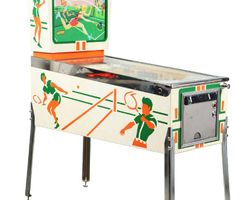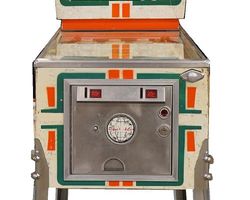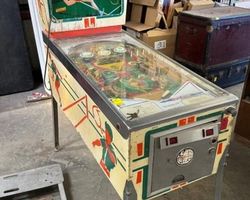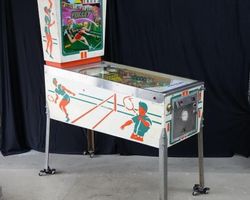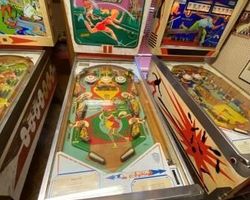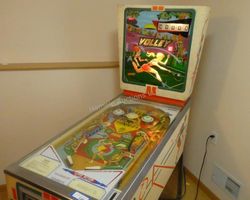Volley

Average Prices: USD $400 to $1,200
Produced: October, 1976
Production Run: 2,900 units
Machine Type: Electro-mechanical
Players: 1
Design by: Ed Krynski
Art by: Gordon Morison
Among the enduring Electro-Mechanical (EM) pinball machines from D. Gottlieb & Co., "Volley" stands as a testament to thoughtful design and engaging gameplay, capturing the spirit of its mid-1970s release. Debuting in August 1976, with the bulk of its 3,013 units produced shortly thereafter in October, "Volley" arrived during a pivotal period for pinball, as the industry began its shift from mechanical ingenuity to the nascent solid-state electronics. Its timely tennis theme capitalized on the surging popularity of the sport in the 1970s, which saw major events like the Billie Jean King and Bobby Riggs "Battle of the Sexes" capture public attention.
The machine’s design was a collaborative effort, with Ed Krynski credited for its layout and Gordon Morison for its distinctive artwork. Krynski, a seasoned designer, imbued "Volley" with a directness that emphasized skill shots and target interaction, a hallmark of many Gottlieb EMs. Morison’s art, characterized by its vibrant 1970s aesthetic and colorful tennis imagery, provided a strong visual identity. An interesting facet of "Volley's" production history involves Gottlieb's experimentation with materials. Due to a spike in plywood prices, some "Volley" playfields were notably constructed from chipboard, featuring paint directly over the flipper swipe area and top arch. While this material choice could lead to a rougher surface over time, it speaks to the adaptive nature of manufacturing during this period. Beyond its domestic sales, "Volley" also saw significant export, with its total production reflecting its broad appeal. Early sample games of "Volley" even featured different playfield artwork compared to the final production version, a detail that hints at the iterative design process inherent in pinball manufacturing.
Signature Features and Design
"Volley's" defining characteristic is its prolific use of drop targets. The game boasts an impressive 15 drop targets, arranged in three distinct banks of five. These banks, often color-coded, are the central interactive elements on the playfield, serving not merely as static obstacles but as dynamic components that dictate the flow and strategy of the game. Unlike many machines of its era, "Volley" intentionally omits active slingshots in the lower playfield. This design choice, rather than diminishing gameplay, channels all the ball's energy and rebounds directly into the target arrays, fostering a genuine "volley" effect as the ball careens between the banks. The satisfying thud of a dropping target, combined with the classic Gottlieb chimes that punctuate each successful hit, provides immediate, visceral feedback. The game's mechanical reels for score display further ground it firmly in the beloved EM tradition, offering a tangible sense of progression with each point accrued. Gordon Morison's artwork, especially on the cabinet, is often lauded for its balanced composition and evocative portrayal of the tennis theme, capturing the energetic spirit of the sport.
Playfield and Mechanics
The "Volley" playfield is structured to encourage precision and strategic target engagement. The upper playfield features three rollover lanes, each corresponding to one of the three five-bank drop target sets situated below. These rollovers are crucial, as they illuminate the respective target bank, significantly increasing the points awarded for hitting those targets. The heart of the playfield lies in these three banks of drop targets, strategically placed to create natural lanes and rebounds. The lower playfield offers a relatively open space, allowing players to regain control and aim for specific targets or rollovers. Three pop bumpers are positioned strategically on the upper-mid playfield, contributing to unpredictable ball movement and increasing the chances of hitting various targets or collecting higher scores.
The design philosophy behind "Volley's" layout revolves around risk and reward. Players must decide whether to attempt to light a target bank first via the upper rollovers, thereby maximizing their scoring potential, or to go for direct target hits for a lower but consistent point yield. This dynamic is central to the game's immersive quality. The physical artwork on the playfield maintains the vibrant 1970s tennis theme, with bold lines and a bright color palette that guide the eye to the key objectives. While the backglass art, particularly its depiction of tennis players, occasionally draws differing opinions regarding its aesthetic appeal, the overall presentation of the playfield through its art and the simple, effective lighting scheme effectively communicates the game’s objectives and theme. The distinct mechanical sounds produced by the pop bumpers, the drop targets resetting, and the score reels advancing are integral to the game’s classic EM appeal, creating a rich auditory experience that complements the visual and tactile feedback.
Gameplay Dynamics
"Volley" distinguishes itself with a deceptively simple yet strategically rich gameplay dynamic, centered around its unique scoring system and the interaction with its 15 drop targets. The primary objective is to clear the three banks of five drop targets. However, the path to high scores involves a crucial strategic element: activating the corresponding top rollover lane before hitting the targets. Successfully striking a lit target bank yields 5,000 points per target, a substantial reward that compels players to aim for the upper playfield. Conversely, hitting an unlit target only awards 500 points. This disparity transforms simple target shooting into a tactical decision, forcing players to prioritize shots and manage their ball's position.
One of the defining mechanics is the "Volley" action itself. After clearing all five targets in any given bank, that bank will reset, immediately bringing the targets back up for another round of scoring. This rapid reset encourages continuous engagement and allows for sustained rallies between target banks, creating a fluid, addictive play experience. When all three banks of drop targets are cleared, a "Special" feature is activated, typically illuminating the outer top rollover lanes for a valuable bonus or extra ball, adding another layer of objective for high-scoring players. The challenge lies not just in hitting targets, but in mastering the sequence and timing: using the top rollovers to light targets, then skillfully navigating the lower playfield to clear them. This encourages a "one more game" mentality, as players continually refine their strategies to achieve higher scores and unlock the Special.
Reception and Legacy
Among pinball enthusiasts and collectors, "Volley" by Gottlieb is largely regarded as a standout Electro-Mechanical machine, often described as an "under-rated" or "sleeper" title that offers more depth than its straightforward appearance suggests. The machine’s most celebrated aspect is undoubtedly its drop target centric gameplay. Players consistently praise the satisfaction derived from hitting the numerous targets and the engaging challenge of clearing the three five-bank sets. The strategic overlay of lighting targets via the top rollovers for significantly higher points is frequently cited as a key factor in its enduring appeal, preventing the game from becoming merely a target-shooting exercise.
Many enthusiasts express a strong "one more game" pull, attributing it to the addictive nature of the target resets and the continuous pursuit of the "Special" feature. Its pure EM charm, characterized by the mechanical chimes and satisfying thunks of the targets, resonates deeply with those who appreciate the classic pinball experience. For numerous long-time collectors, "Volley" holds a special place, sometimes even considered a "holy grail" machine from the EM era, prized for its replayability and strategic depth. The cabinet artwork, with its vibrant 1970s tennis theme, is generally well-received for its balance and era-appropriate aesthetic, though the backglass art, particularly the depiction of the tennis player, occasionally garners mixed opinions.
While the absence of slingshots is sometimes noted, it is often seen as a deliberate design choice that enhances the unique "volley" interaction between the ball and the target banks, rather than a deficiency. A minority of feedback points to a perceived simplicity or potential for repetitiveness in the ruleset compared to later, more complex solid-state games. However, this is usually outweighed by the appreciation for its focused, skill-based gameplay. "Volley" stands as a testament to Gottlieb's design prowess in the twilight of the EM era, solidifying its reputation as one of the best examples of its type and securing its place as a cherished title within pinball history.
Sponsored Links
 Ebay Listings
Ebay Listings
 Auction Results
Auction Results
| Cost | Location | Date |
|---|---|---|
| USD $850 |  Illinois, United States Illinois, United States |
27 March, 2025 |
| USD $1,750 |  Virginia, United States Virginia, United States |
11 January, 2025 |
| USD $550 |  Wisconsin, United States Wisconsin, United States |
18 April, 2024 |
| USD $1,200 |  New Hampshire, United States New Hampshire, United States |
16 February, 2024 |
| CAD $404 |  Canada Canada |
31 October, 2023 |
| USD $320 |  Texas, United States Texas, United States |
17 April, 2023 |
| USD $1,999 |  Florida, United States Florida, United States |
21 December, 2022 |
| USD $1,500 |  Utah, United States Utah, United States |
03 May, 2022 |
| USD $2,100 |  Virginia, United States Virginia, United States |
02 May, 2022 |
| USD $1,300 |  United States United States |
08 October, 2021 |


Private Policy · Search Website · Contact Us
As an eBay Partner, we may earn a commission from qualifying purchases made through links on this site, at no additional cost to you.
All trademarks and copyrighted materials remain property of their respective owners. All other content copyright 2007 - 2025 Pinpedia.

